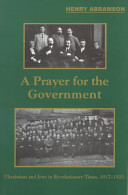
Examining the relationship between Ukrainians and Jews in Revolutionary Times, 1917-1920.
Written and narrated by Peter Bejger.
Centennials offer moments for reflection. The one hundredth anniversary of a major turning point in history provides an excellent opportunity for re-evaluation and reconsideration.
In the spring of 1917 the Russian Empire came to an abrupt end. The Russian Revolution consumed the former imperial capital of Petrograd. Ukraine was breaking away, and Jewish and Ukrainian political leaders in Kyi v moved boldly to set up a striking new relationship between the two nationalities.
v moved boldly to set up a striking new relationship between the two nationalities.
This new relationship—and its eventual failure—is examined in the book A Prayer for the Government: Ukrainians and Jews in Revolutionary Times, 1917-1920, published in 1999.
The author, Dr. Henry Abramson, serves as Dean at Touro’s Lander College of Arts and Sciences in Brooklyn, New York. A native of northern Ontario, he received his PhD in History from the University of Toronto in 1995. He has gone on to visiting and post-doctoral positions at Cornell, Harvard, Oxford, and the Hebrew University of Jerusalem.
Abramson writes that a potential newborn friendship between Ukrainians and Jews emerged in that revolutionary year of 1917. This was a tentative rapprochement between two groups that had lived for centuries in what Abramson calls an “intimate insularity.”
This newborn friendship at first blossomed, resulting in the appointment by the new Ukrainian government of the first Minister of Jewish Affairs in modern history. This was an attempt to provide Jewish political autonomy in the new Ukrainian state.
It was what Abramson called a bright chapter in the long history of the Jewish people. One in which Jews were emancipated into a free state. And they were given privileges as a minority that exceeded even those in Western Europe and America.
However, Abramson points out Ukrainian parties could not communicate their liberal program to the peasantry. And he noted Jewish activists were too far removed from the ordinary Jewish citizen to mobilize widespread support for the Ministry of Jewish Affairs.
By the spring of 1919 Ukraine was submerged by a wave of violence. This was one of the darkest chapters of Jewish history, with pogroms that were only overshadowed later by the Holocaust.
Abramson’s meticulous account traces how the attempt by both Jews and Ukrainians to achieve a working political relationship was betrayed by less enlightened attitudes among the general population.
Abramson also addresses the national agendas that have emerged in the historiography of Ukrainian-Jewish relations during the revolution. This issue has been particularly fraught since the assassination of the Ukrainian revolutionary leader Symon Petliura in Paris in 1926. His assassin, Samuel Schwartzbard, was acquitted in a controversial trial.
Abramson acknowledges the trial has overshadowed Ukrainian-Jewish relations, and heavily influenced historical research, up to this very day. Scholars have attempted to either justify or condemn the trial’s outcome. Most studies have focused on either the anti-Jewish pogroms or the participation of Jews in the Ukrainian revolutionary movement. Abramson’s stated goal is to provide a synthesis of these two trends and to achieve a more comprehensive understanding of the period.
At the end of the day Abramson concedes that the prognosis for Jewish autonomy in Ukraine, and by extension cordial Jewish-Ukrainian relations, was poor. He notes that first of all, the stratum of society that participated in the rapprochement between the two communities was too thin. It was not well grounded in the population at large.
Most importantly, the political and social situation in Ukraine was simply too unstable. Abramson reminds us the young Ukrainian state was confronted with hostile neighbors on all sides. The struggle for Ukrainian independence in the years 1917-1920 was marked by chaos.
Abramson writes, “As the Great War dragged into revolution, foreign occupation, and again revolution, the unrest and disorder provided an opportunity for hooligans and criminals to terrorize the population. These thugs—whether in military uniform or not—found minorities to be an attractive target.”
Revolutions liberate but also remove restraints. Abramson found the title for his detailed study of this tumultuous era from a quote from the Torah by Rabbi Hanina, the Deputy High Priest, who said: “Pray for the welfare of the government, for were it not for the fear of it, people would swallow each other alive.”
A Prayer for the Government: Ukrainians and Jews in Revolutionary Times, 1917-1920, was distributed by Harvard University Press for the Ukrainian Research Institute and Center for Jewish Studies at Harvard University. The book can be ordered from Amazon.com.
This has been Ukrainian Jewish Heritage on Nash Holos Ukrainian Roots Radio. From San Francisco, I’m Peter Bejger. Until next time, shalom!

